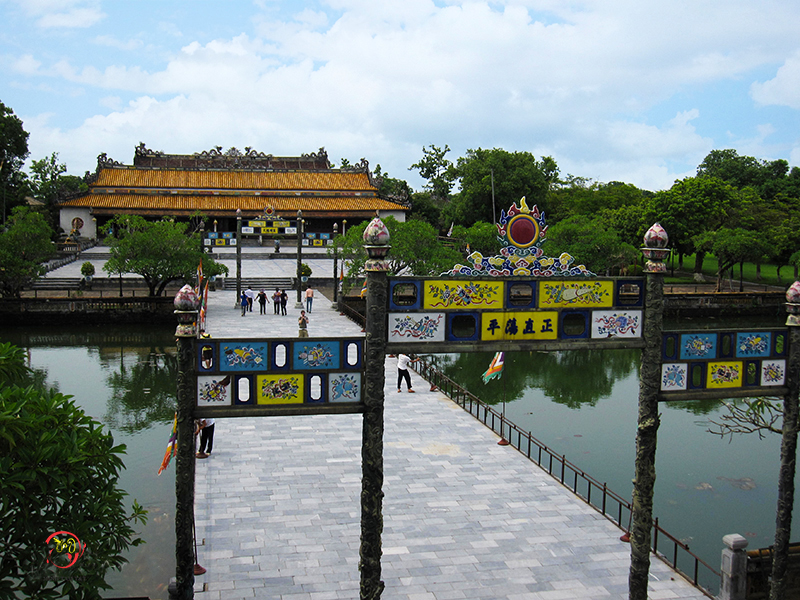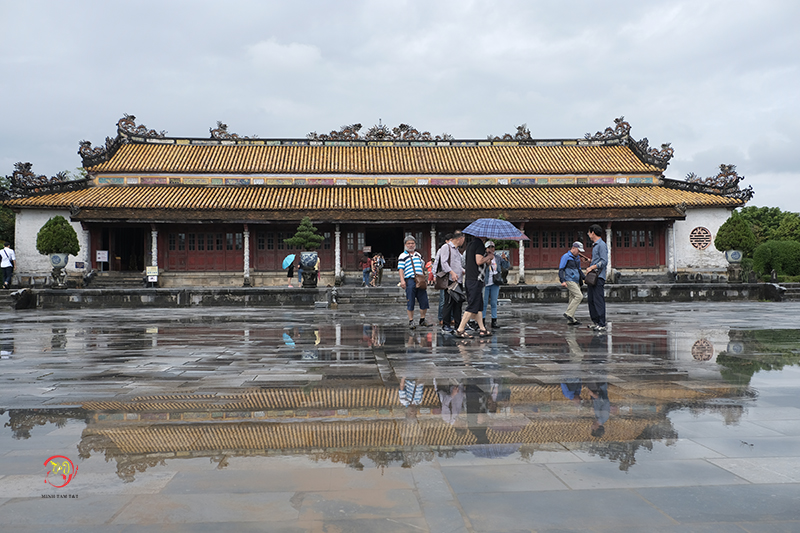Location: Throne Palace (Dien Thai Hoa) faces the Ngo Mon Gate and lies right on the central axis of the Hue Citadel.
Characteristics: The Throne Palace, or Palace of the Supreme Harmony, was the building for great court’s meetings. It was constructed in 1805 by Emperor Gia Long and used later in 1806 for his coronation.

In 1833, it was moved onto a foundation of 2.33m high by Emperor Minh Mang. It is 44m long, 30.50m large, 11.80m high and contains a 5-compartment, two-bay main building connected with a 7-compartment, two-bay front building. The columns are lacquered red and decorated with golden dragon designs. On the roof ridge rest two dragon designs paying homage to the moon. Eaves and roof corners are ornamented with head-turning dragon designs. These and the moldings along the eaves are inlaid with multicolored ceramic chips. The roof is covered with yellow enameled tiles.
Over the middle compartment hangs a carved board with big Chinese characters “Thai Hoa Dien” (Palace of Supreme Harmony). Inside is the throne, covered by a golden canopy with brocaded circular dragon designs. Above each compartment hangs a colorful glass-sided hexagonal or octagonal lantern. In 1839, in an attempt to adorn this historic monument, Emperor Minh Mang ordered the framework to be lacquered red and gold. It was later supplied with European-styled paving by Emperor Thanh Thai, in 1899, and colored glass door on front and back sides by Emperor Khai Dinh, in 1923. (It was originally left open and shaded with blinds only).
The interior decorations include some jugs and other antiques. On the court stands a line of carved pedestals, each with a vase for rare plants. Constructors of the Throne Palace have succeeded masterly in creating two contradictory features: cool in summer and warm in winter. From the throne in the center, one can also distinctively hear sounds made anywhere in the palace. Of this phenomenon, no researcher in acoustics or architecture could ever give an exact explanation.

The great court in front of the palace, known as the Great Rites Court (or Esplanade of Great Salutation), is paved with Thanh stones and consists of two terraces: the upper was reserved for high-ranking civil and military mandarins. On both sides of the court are two rows of small steles called Pham Son showing the positions mandarins should take according to their ranks.
The lower terrace, beside the Trung Dao (Central Path) Bridge, is for elders and village authorities in ceremonial occasions. At both corners of the court stand two bronze Kylins. Kylin is traditionally a harbinger of peace and a reminder of ritual solemnity.
Between Ngo Mon Gate and the court is the Thai Dich Lake (Grand Liquid Lake), dug in 1833 and spanned by the Trung Dao (Central Path) Bridge. The bridge, secured by iron banisters, connects the two monuments. At both ends we find a gateway elaborately carved with five-clawed dragon designs in high relief (dragons among clouds on bronze columns). Though symmetrically built, the two columns with two dragons, one slithering down and one soaring up really create an attractive liveliness.
The Throne Palace is the site where solemn ceremonies took place such as: the Coronation Day, the Crown Prince Coronation Day, the Ambassador Receiving Ceremony, Emperor’s Birthday Anniversaries, etc. Great meetings were held here twice a month while regular ones took place in the Can Chanh Palace (Palace of Audiences) behind the Great Golden Gate. The Palace was seriously damaged in 1968 during the American bombings. Typhoons, rains and floods have aggravated the calamity and thus deprived the monument of original appearance.
Source: Vietnamtourism.vn
